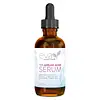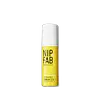What's inside
What's inside
 Key Ingredients
Key Ingredients

 Benefits
Benefits

 Concerns
Concerns

No concerns
 Ingredients Side-by-side
Ingredients Side-by-side

Aloe Barbadensis Leaf Juice
Skin ConditioningAzelaic Acid
BufferingGlycerin
HumectantNiacinamide
SmoothingSorbitol
HumectantLecithin
EmollientTocopheryl Acetate
AntioxidantGlyceryl Linoleate
EmollientGlyceryl Linolenate
EmollientRetinyl Palmitate
Skin ConditioningSodium Ascorbyl Phosphate
AntioxidantXanthan Gum
EmulsifyingSodium Hyaluronate
HumectantPullulan
Leptospermum Scoparium Branch/Leaf Oil
TonicCentipeda Cunninghamii Extract
Skin ConditioningAscorbic Acid
AntioxidantDisodium EDTA
Gluconolactone
Skin ConditioningSodium Benzoate
MaskingPhenoxyethanol
PreservativeAloe Barbadensis Leaf Juice, Azelaic Acid, Glycerin, Niacinamide, Sorbitol, Lecithin, Tocopheryl Acetate, Glyceryl Linoleate, Glyceryl Linolenate, Retinyl Palmitate, Sodium Ascorbyl Phosphate, Xanthan Gum, Sodium Hyaluronate, Pullulan, Leptospermum Scoparium Branch/Leaf Oil, Centipeda Cunninghamii Extract, Ascorbic Acid, Disodium EDTA, Gluconolactone, Sodium Benzoate, Phenoxyethanol
Water
Skin ConditioningButylene Glycol
HumectantNiacinamide
SmoothingPolyglycerin-6
HumectantSorbitan Laurate
EmulsifyingGlycerin
HumectantAzelaic Acid
BufferingC15-19 Alkane
SolventCarbomer
Emulsion StabilisingPotassium Cetyl Phosphate
EmulsifyingCeramide NP
Skin ConditioningCeramide AP
Skin ConditioningCeramide EOP
Skin ConditioningAcetyl Hexapeptide-1
Skin ConditioningBisabolol
MaskingInulin
Skin ConditioningSodium Lauroyl Lactylate
EmulsifyingGluconolactone
Skin ConditioningBetaine
HumectantSodium Hydroxide
BufferingAlpha-Glucan Oligosaccharide
CleansingPolyglyceryl-4 Laurate
EmulsifyingSodium Benzoate
MaskingCetrimonium Bromide
AntimicrobialDilauryl Citrate
EmollientPhenoxyethanol
PreservativePhytosphingosine
Skin ConditioningCholesterol
EmollientXanthan Gum
EmulsifyingEthylhexylglycerin
Skin ConditioningCalcium Gluconate
HumectantCaprylyl Glycol
EmollientWater, Butylene Glycol, Niacinamide, Polyglycerin-6, Sorbitan Laurate, Glycerin, Azelaic Acid, C15-19 Alkane, Carbomer, Potassium Cetyl Phosphate, Ceramide NP, Ceramide AP, Ceramide EOP, Acetyl Hexapeptide-1, Bisabolol, Inulin, Sodium Lauroyl Lactylate, Gluconolactone, Betaine, Sodium Hydroxide, Alpha-Glucan Oligosaccharide, Polyglyceryl-4 Laurate, Sodium Benzoate, Cetrimonium Bromide, Dilauryl Citrate, Phenoxyethanol, Phytosphingosine, Cholesterol, Xanthan Gum, Ethylhexylglycerin, Calcium Gluconate, Caprylyl Glycol
 Reviews
Reviews

Ingredients Explained
These ingredients are found in both products.
Ingredients higher up in an ingredient list are typically present in a larger amount.
Azelaic acid is a multitasker ingredient that helps treat acne, pigmentation, and irritation. It is a great option for sensitive skin.
What makes azelaic special?
The best thing about azelaic acid is it's gentleness. It's generally well-tolerated and safe to use alongside other actives like niacinamide or salicylic acid.
Unlike AHAs, azelaic acid will not make you photosensitive/sun sensitive.
You can find this ingredient naturally occurring in grains like wheat, rye, and barley. In cosmetics, azelaic acid is typically lab-made, which is more stable and effective.
Learn more about Azelaic AcidGluconolactone is a PHA. PHAs are a great gentle alternative to traditional AHAs.
When applied, Gluconolactone has the same affect on skin as AHAs such as lactic acid. It helps dissolve the dead skin cells in the top layer of your skin. This improves texture and brightens the skin.
PHAs are more gentle than AHAs due to their larger structure. They do not penetrate as deeply as AHAs and take a longer time to dissolve dead cells. Studies show PHAs do not cause as much irritation.
Gluconolactone has some interesting properties:
In a 2004 study, Gluconolactone was found to prevent UV damage in mouse skin cells and has not been found to increase sun sensitivity. However, we still recommend wearing SPF daily.
This ingredient is is an created by reacting gluconic acid with an alcohol.
Learn more about GluconolactoneGlycerin is already naturally found in your skin. It helps moisturize and protect your skin.
A study from 2016 found glycerin to be more effective as a humectant than AHAs and hyaluronic acid.
As a humectant, it helps the skin stay hydrated by pulling moisture to your skin. The low molecular weight of glycerin allows it to pull moisture into the deeper layers of your skin.
Hydrated skin improves your skin barrier; Your skin barrier helps protect against irritants and bacteria.
Glycerin has also been found to have antimicrobial and antiviral properties. Due to these properties, glycerin is often used in wound and burn treatments.
In cosmetics, glycerin is usually derived from plants such as soybean or palm. However, it can also be sourced from animals, such as tallow or animal fat.
This ingredient is organic, colorless, odorless, and non-toxic.
Glycerin is the name for this ingredient in American English. British English uses Glycerol/Glycerine.
Learn more about GlycerinNiacinamide is a multitasking form of vitamin B3 that strengthens the skin barrier, reduces pores and dark spots, regulates oil, and improves signs of aging.
And the best part? It's gentle and well-tolerated by most skin types, including sensitive and reactive skin.
You might have heard of "niacin flush", or the reddening of skin that causes itchiness. Niacinamide has not been found to cause this.
In very rare cases, some individuals may not be able to tolerate niacinamide at all or experience an allergic reaction to it.
If you are experiencing flaking, irritation, and dryness with this ingredient, be sure to double check all your products as this ingredient can be found in all categories of skincare.
When incorporating niacinamide into your routine, look out for concentration amounts. Typically, 5% niacinamide provides benefits such as fading dark spots. However, if you have sensitive skin, it is better to begin with a smaller concentration.
When you apply niacinamide to your skin, your body converts it into nicotinamide adenine dinucleotide (NAD). NAD is an essential coenzyme that is already found in your cells as "fuel" and powers countless biological processes.
In your skin, NAD helps repair cell damage, produce new healthy cells, support collagen production, strengthen the skin barrier, and fight environmental stressors (like UV and pollution).
Our natural NAD levels start to decline with age, leading to slower skin repair, visible aging, and a weaker skin barrier. By providing your skin niacinamide, you're recharging your skin's NAD levels. This leads to stronger, healthier, and younger looking skin.
Another name for vitamin B3 is nicotinamide. This vitamin is water-soluble and our bodies don't store it. We obtain Vitamin B3 from either food or skincare. Meat, fish, wheat, yeast, and leafy greens contain vitamin B3.
The type of niacinamide used in skincare is synthetically created.
Learn more about NiacinamidePhenoxyethanol is a preservative that has germicide, antimicrobial, and aromatic properties. Studies show that phenoxyethanol can prevent microbial growth. By itself, it has a scent that is similar to that of a rose.
It's often used in formulations along with Caprylyl Glycol to preserve the shelf life of products.
Sodium Benzoate is a preservative. It's used in both cosmetic and food products to inhibit the growth of mold and bacteria. It is typically produced synthetically.
Both the US FDA and EU Health Committee have approved the use of sodium benzoate. In the US, levels of 0.1% (of the total product) are allowed.
Sodium benzoate works as a preservative by inhibiting the growth of bacteria inside of cells. It prevents the cell from fermenting a type of sugar using an enzyme called phosphofructokinase.
It is the salt of benzoic acid. Foods containing sodium benzoate include soda, salad dressings, condiments, fruit juices, wines, and snack foods.
Studies for using ascorbic acid and sodium benzoate in cosmetics are lacking, especially in skincare routines with multiple steps.
We always recommend speaking with a professional, such as a dermatologist, if you have any concerns.
Learn more about Sodium BenzoateXanthan gum is used as a stabilizer and thickener within cosmetic products. It helps give products a sticky, thick feeling - preventing them from being too runny.
On the technical side of things, xanthan gum is a polysaccharide - a combination consisting of multiple sugar molecules bonded together.
Xanthan gum is a pretty common and great ingredient. It is a natural, non-toxic, non-irritating ingredient that is also commonly used in food products.
Learn more about Xanthan Gum